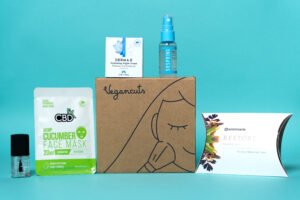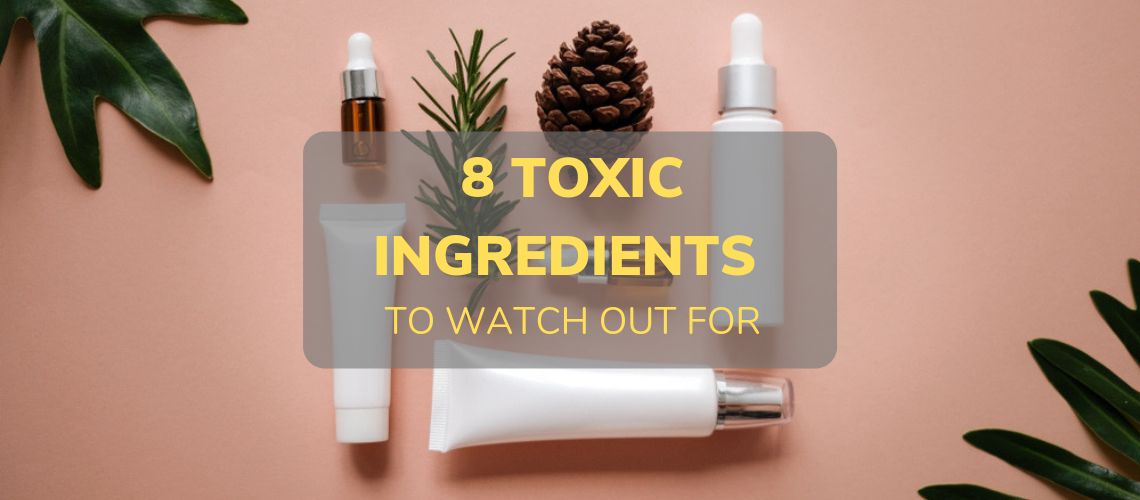When it comes to beauty products, it pays to be aware of the ingredients you’re using.
This is because there is a long list of harmful ingredients found in skincare and makeup products that aren’t government unregulated.
As beauty box curators on the frontlines of the beauty industry, it’s safe to say we’ve learned a lot about what harsh chemicals can go into beauty and how to avoid them.
Interested in cruelty-free skincare? Check out our Complete Vegan Skincare Guide.
How To Know Which Beauty Products Contain Harmful Ingredients?

They say, “when it comes to beauty, it’s what’s on the inside that counts”. Well – the same goes for beauty products.
To ensure you’re avoiding harmful chemicals, always check the ingredient list on the back of the product.
Consumers can often be drawn in by beautiful packaging, or alluring words like “volumizing” or “extra hold“. But it’s the ingredients that will tell the real story.
Even products listed as vegan and clean can sometimes be misleading. This keeps our beauty box curator active, making sure each and every beauty product curated is 100% non-toxic and vegan so subscribers can be at ease.
Learn more about the Vegancuts Beauty Box.
Why Do Some Beauty Products Contain Harmful Ingredients?

There are harmful ingredients in a lot of products we consume and use on a daily basis. But there is no industry with less regulation than the beauty and makeup industry.
The American cosmetics industry is worth a whopping $70 billion every year (1). However, the FDA’s Office of Cosmetics and Colors only has an annual budget of $8 million and 27 staff members. It gets worse – The Food, Drug, and Cosmetic Act was the last set of laws passed to govern cosmetics, and this passed in 1938. Many years later, we have millions of beauty brands using a wide variety of ingredients and formulating techniques that need to be regulated.
The EU bans 1328 chemicals, Canada bans 600, but the U.S. bans only 30. Whether it’s for your long-term health, immediate skin irritation, ethics, or bioaccumulation, we should all be taking a closer look at the ingredients in our favorite products and every future purchase.
If you see any of the ingredients listed below in your collection of skincare and cosmetics, it may be time to transition into clean beauty.
Harmful Chemicals In Beauty Products:
Here is a list of the most common harmful products found in beauty products.
1. Preservatives & Stabilizing Agents: Parabens, BHA, BHT
Parabens are a commonly-used preservative found in personal care products and cosmetics. When first transitioning to non-toxic beauty, look for parabens as they are the easiest to scope out.
They are found in the majority of cosmetics, although sometimes unmarked as part of the fragrances. (Did you know that fragrances don’t have to be disclosed to the public as they are considered a trade secret?) Parabens can easily penetrate your skin, even if your product doesn’t have skin absorption enhancers, bypass the metabolic process, and can enter both the bloodstream and organs without being broken down.
The scary fact is that parabens mimic estrogen, which can potentially interfere with hormone production in both men and women. Parabens have been linked to breast cancer (2), because they have been detected in the breast tissue of many breast cancer patients. Last but not least, parabens are not environmentally-friendly, as they are resistant to biodegradation in both water and oil.
Other preservatives to look out for are BHA (butylated hydroxyanisole) and BHT (butylated hydroxytoluene). Like parabens, they are suspected endocrine disrupters and carcinogens. Even worse, they are carcinogens for fish and other wildlife.
Consumers have to understand that every product used gets washed down the drain in some form — the shower drain, sink drain, or during the recycling process. These two chemicals are both bioaccumulative and dangerous to aquatic species.
2. Foaming Agents: Sulfates
Sulfates are what make beauty commercials so enticing. Sulfates produce the suds for the shampoo, body wash, and shaving cream close-up shots. Suds are supposed to imply a luxurious and moisturizing product, but instead, sulfates are synthetic, non-renewable ingredients generally derived from petroleum that strip the skin of its natural oils and cause severe skin irritation.
Sodium Lauryl Sulfate (SLS) can remain in the body for up to five days, staying behind in your vital organs, can damage your immune system, and mutate into carcinogens. Another chemical that performs the same function would be DEA (Diethanolamine), which is mainly used as a pH adjuster (3). This chemical can have effects on the nervous and endocrine system.
3. Plasticizers: Phthalates
Phthalates are a group of chemicals that help dissolve other chemicals and make plastic more flexible. They can be found in everything from vinyl flooring to shampoo, often hidden in the fragrance. Phthalates are bioaccumulative and are endocrine disrupters to both humans and aquatic animals.
4. Antibacterials: Triclosan
Undoubtedly, not all antibacterials are bad. But triclosan is a synthetic antibacterial that functions as a pesticide. It is a commonly-found chemical in many types of drugstore toothpaste and household cleaners. Unfortunately, this chemical is a hormone disruptor and can decrease fertility, produce birth defects, or alter DNA. This chemical, too, is bioaccumulative and also harmful to aquatic animals.
5. Formaldehyde Releasers: DMDM Hydantoin, Imidazolidinyl urea, Quaternium-15, and others.
Formaldehyde and formaldehyde-releasing preservatives are used in many personal care products, particularly liquid baby soaps, hair smoothing products, nail polish, and color cosmetics. When formaldehyde is present in a product, consumers can be exposed by ingestion or absorption, which can cause irritation at best and cancer at worst (5).
6. Chemical Sunscreens: Oxybenzone, Avobenzone, Octisalate, Octocrylene, Octinoxate.
Mineral sunscreens, like zinc oxide, will sit on your skin to reflect the light to prevent damage. Chemical sunscreens will penetrate your skin, absorb the UV rays, and convert them into heat that is then released through the skin.
But unlike mineral sunscreens, chemical sunscreens can stay in the body for up to five days (6). Additionally, many chemical sunscreens are not considered “reef safe” and are already banned, or will soon be banned, around the world for damaging our reefs. When it’s washed off your body in the water, it stays and actually damages some of the Earth’s most precious ecosystems.
7. Light and Heavy Metals: Aluminum and Lead
Aluminum, a light metal, can be found in many drugstore deodorants, with its main function as an antiperspirant. The deodorants will have aluminum salts that help plug the pores physically preventing you from sweating. Not only has this been linked to increasing your chances of breast cancer (7), but it’s blocking your natural production of sweat.
On the other hand, heavy metals are less obvious to spot, as they are often not added purposely, but are contaminants (8). Such is the case for the infamous Claire’s asbestos scandal (9) when a mother found asbestos in a variety of her young girl’s makeup palettes.
8. Water Retainers: Mineral Oils & Petrolatum
Petrolatum and mineral oils, a liquid mixture derived from petrolatum, are used in many personal care products to retain moisture. This is why you will often see it as the main ingredient for lotions, cleansers, lip balms, and even powders. The big problem is that as they keep water in, they also clog the pores and prevent your skin from breathing.
Used regularly, this will age your skin prematurely, and as it’s a carcinogen and endocrine disrupter, they can lead to cancer in humans and breathing problems in animals. You should also keep a lookout for 1,4-Dioxane, a common byproduct of processing petroleum-based products produced while trying to make the petrolatum less irritating to the skin. 1,4-Dioxane is resistant to biodegradation in water and soil as well as being potentially explosive when exposed to light or air (10) – definitely not something we want in our cosmetics.
How To Transition To Non-Toxic Beauty Products

The good news about transitioning to clean beauty is there are so many non-toxic alternatives to choose from.
While it may be tough to get rid of a beloved eyeshadow palette or lip gloss, knowing your transitioning to cleaner ingredients is better for you and the planet can help let go.
As you continue to shop and replace your items one by one, you’ll get familiar with ingredients labels and start to lean on brands you can trust.
If discovering products and brands one-by-one seems daunting or time-consuming, simply look for an EWG-Verified brand or subscribe to Vegancuts.

Vegancuts provides monthly beauty boxes with cruelty-free, vegan, and clean beauty items, a.k.a non-toxic skincare, and cosmetics, so the work is done for you. Use the coupon code veganskincare to get $5 off your first box.
